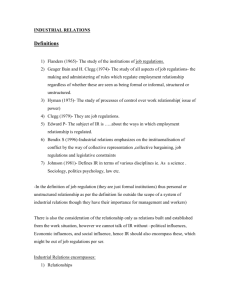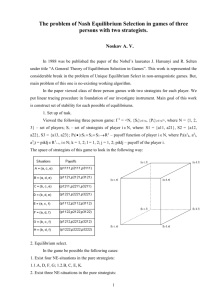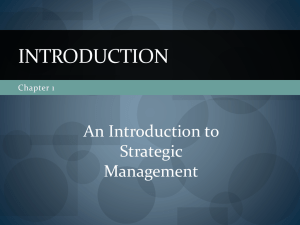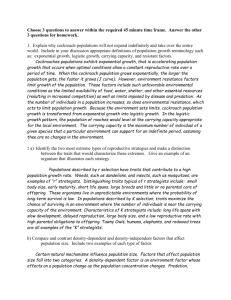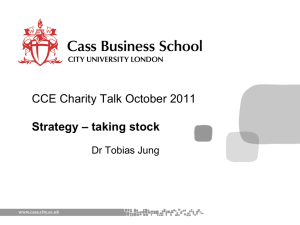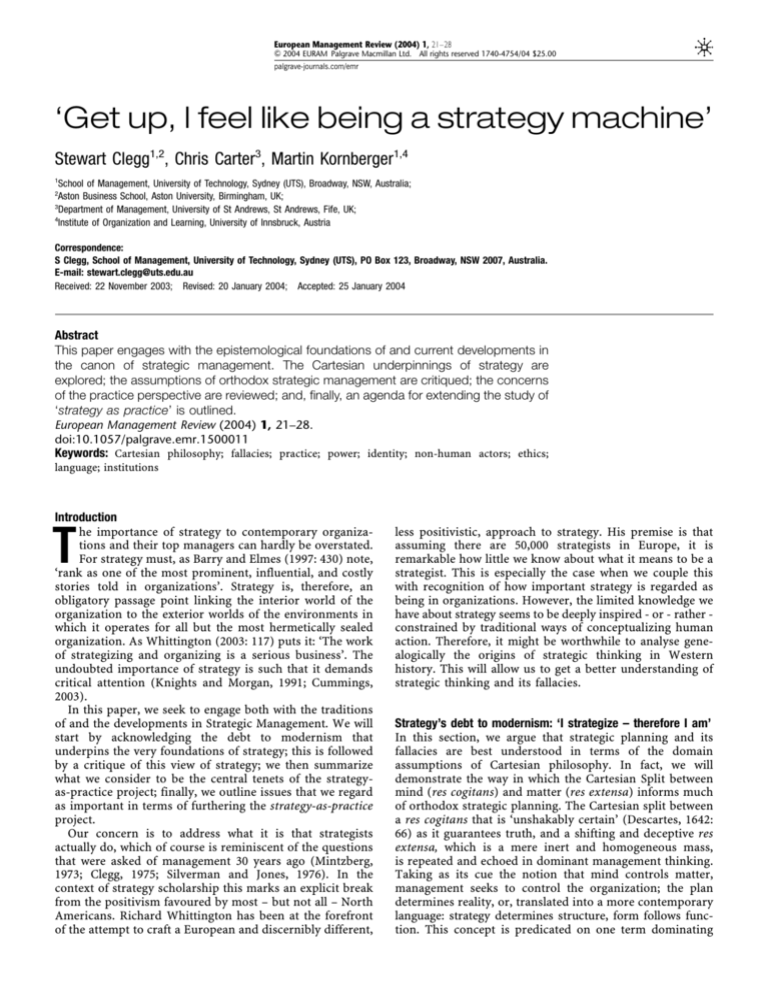
European Management Review (2004) 1, 21–28
& 2004 EURAM Palgrave Macmillan Ltd. All rights reserved 1740-4754/04 $25.00
palgrave-journals.com/emr
‘Get up, I feel like being a strategy machine’
Stewart Clegg1,2, Chris Carter3, Martin Kornberger1,4
1
School of Management, University of Technology, Sydney (UTS), Broadway, NSW, Australia;
Aston Business School, Aston University, Birmingham, UK;
3
Department of Management, University of St Andrews, St Andrews, Fife, UK;
4
Institute of Organization and Learning, University of Innsbruck, Austria
2
Correspondence:
S Clegg, School of Management, University of Technology, Sydney (UTS), PO Box 123, Broadway, NSW 2007, Australia.
E-mail: stewart.clegg@uts.edu.au
Received: 22 November 2003; Revised: 20 January 2004; Accepted: 25 January 2004
Abstract
This paper engages with the epistemological foundations of and current developments in
the canon of strategic management. The Cartesian underpinnings of strategy are
explored; the assumptions of orthodox strategic management are critiqued; the concerns
of the practice perspective are reviewed; and, finally, an agenda for extending the study of
‘strategy as practice’ is outlined.
European Management Review (2004) 1, 21–28.
doi:10.1057/palgrave.emr.1500011
Keywords: Cartesian philosophy; fallacies; practice; power; identity; non-human actors; ethics;
language; institutions
Introduction
he importance of strategy to contemporary organizations and their top managers can hardly be overstated.
For strategy must, as Barry and Elmes (1997: 430) note,
‘rank as one of the most prominent, influential, and costly
stories told in organizations’. Strategy is, therefore, an
obligatory passage point linking the interior world of the
organization to the exterior worlds of the environments in
which it operates for all but the most hermetically sealed
organization. As Whittington (2003: 117) puts it: ‘The work
of strategizing and organizing is a serious business’. The
undoubted importance of strategy is such that it demands
critical attention (Knights and Morgan, 1991; Cummings,
2003).
In this paper, we seek to engage both with the traditions
of and the developments in Strategic Management. We will
start by acknowledging the debt to modernism that
underpins the very foundations of strategy; this is followed
by a critique of this view of strategy; we then summarize
what we consider to be the central tenets of the strategyas-practice project; finally, we outline issues that we regard
as important in terms of furthering the strategy-as-practice
project.
Our concern is to address what it is that strategists
actually do, which of course is reminiscent of the questions
that were asked of management 30 years ago (Mintzberg,
1973; Clegg, 1975; Silverman and Jones, 1976). In the
context of strategy scholarship this marks an explicit break
from the positivism favoured by most – but not all – North
Americans. Richard Whittington has been at the forefront
of the attempt to craft a European and discernibly different,
T
less positivistic, approach to strategy. His premise is that
assuming there are 50,000 strategists in Europe, it is
remarkable how little we know about what it means to be a
strategist. This is especially the case when we couple this
with recognition of how important strategy is regarded as
being in organizations. However, the limited knowledge we
have about strategy seems to be deeply inspired - or - rather constrained by traditional ways of conceptualizing human
action. Therefore, it might be worthwhile to analyse genealogically the origins of strategic thinking in Western
history. This will allow us to get a better understanding of
strategic thinking and its fallacies.
Strategy’s debt to modernism: ‘I strategize – therefore I am’
In this section, we argue that strategic planning and its
fallacies are best understood in terms of the domain
assumptions of Cartesian philosophy. In fact, we will
demonstrate the way in which the Cartesian Split between
mind (res cogitans) and matter (res extensa) informs much
of orthodox strategic planning. The Cartesian split between
a res cogitans that is ‘unshakably certain’ (Descartes, 1642:
66) as it guarantees truth, and a shifting and deceptive res
extensa, which is a mere inert and homogeneous mass,
is repeated and echoed in dominant management thinking.
Taking as its cue the notion that mind controls matter,
management seeks to control the organization; the plan
determines reality, or, translated into a more contemporary
language: strategy determines structure, form follows function. This concept is predicated on one term dominating
I feel like being a strategy machine
Stewart Clegg et al
22
the other through the imposition of a hierarchical relation;
in fact, it constitutes a system of divisions and gaps that
constantly undermine, subvert or, spoken with a more
fashionable language, deconstruct, efforts to impose order
on the organization. We will argue that this process creates
a system of dualism in which one term logically and
empirically needs and refers to the other without being able
to comprehend the complexities of this dynamic.
According to Descartes (1642), the mind detects the laws
of the passive and inert res extensa in order to gain control
over it. The mind is the active, sensemaking and dominating source of human power over the mere extensive bodies
in a world ‘out there’, such that, ‘[a]fter examination we
shall find that there is nothing remaining in the idea of
body excepting that it is extended in length, breadth and
depth’ (Descartes, 1642: 259). While the body is mere res
extensa, thinking happens in the res cogitans, in the mind
strictly divided from the body. This hierarchical relation
became the driving force behind Western thinking.
Not surprisingly, Cartesian imagery frames and is
reproduced in the discourse of strategic management. The
split between mind and body is reflected in the gap between
strategy and operations: while the former analyses,
controls, leads, thinks and plans, the latter appears as a
mere, inert and passive object that has to be directed.
Management as the ‘head’ creates visions, strategies and
plans in order to dominate and lead the organization (the
‘body’). In strategy, this domination of mind over matter, of
head over body, was established explicitly both by Alfred
Chandler’s (1962) theory of structure following strategy
and earlier, and more mundanely, in FW Taylor’s (1947)
scientific management.
Using Chandler as example, we understand that his
analyses raised a new conceptual object – the strategic plan
that drives, dominates and determines organizational
structure. Reflecting on strategies became an inevitable
means to success ‘in response to the opportunities and
needs created by changing population and changing
national income and by technological innovation’ (Chandler, 1962: 15). Put simply, changes in the environment
create a need for new strategies, a theme endlessly repeated
by contingency theory; as a consequence, these new strategies require a new organizational structure (note the
functional language of needs). In both steps, the organization reacts passively: first, it is a passive victim of environmental changes to which it responds through developing
adequate strategies. Strategy, again, is a reaction to which
structure then reacts. Structure follows strategy and
strategy is driven by environmental changes. The chain of
cause and effect is linear, simple and trivial, but nonetheless
decisive: ‘Unless structure follows strategy, inefficiency
rules’ (Chandler, 1962: 314).
A whole range of arguments seek to justify this hierarchy:
management must plan in order to coordinate an organization’s activities; to ensure that the future is taken into
account; to be rational, and to control (Mintzberg, 1994:
16–19). Thus, strategy and strategic planning especially can
be seen as an example of what Nietzsche (1968) analysed
as the ‘will to power’ – the will to control, predict and
dominate the future. As he argued, plans are one of the
most effective and common devices used to try and exercise
power over things and people. The plan is a means ‘which
can eliminate and incorporate uncertainty’ (Tsivacou, 1996:
70; Kallinikos, 1996; Kallinikos and Cooper, 1996). It is
meant to predict the future and thus render the incalculable
tomorrow into a predictable and thus controllable pattern.
The plan as modern form of rationality is but one stone in
the big mosaic that Max Weber saw when he coined the
phrase of the ‘iron cage’. Given the Cartesian underpinning
of strategy, it is worthwhile exploring how this manifests
itself in the ‘doxa’ or assumptions that lay unchallenged and
are regarded as being resolutely commonsensical.
Seven fallacies of strategic management
The Cartesian origins of strategy grew into what we can
identify as the seven fallacies of strategic planning. They
constitute themselves in terms of seven gaps: (i) the gap
between managerial fantasy and organizational capabilities;
(ii) the gap between actual, clear goals and possible,
unpredictable futures; (iii) the gap between planning and
implementing; (iv) the gap between planned change and
emerging evolution; (v) the gap between means and ends;
(vi) the gap between a planning head (management) and
a planned body (organization); and finally, (vii) the gap
between order and disorder.
Far from managing these gaps, strategic planning actively
generates and sustains them. The practice of strategic
planning is what initially constitutes these gaps. It actively
creates a system of divisions that constantly undermines
and subverts the order that the strategic plan proposes. It is
this congenital subversion that incessantly de- and reconstructs the logic of the plan, such that the innermost
essence of strategic planning constantly erodes the order it
promises to impose. Thinking and managing beyond such
strategic practice inspired by Cartesian logic, which is an
exercise that constantly undermines itself, and hence the
entire organization, must instead be conceptualized in
terms of strategy as practice that focuses on aspects other
than merely prescriptive Cartesianism. We will return to
this point after briefly describing the seven fallacies of
strategic thinking.
First, there is the gap between managerial fantasy and
organizational capabilities. As Bartlett and Ghoshal pointed
out, organizations are captured in a ‘strategic trap’: ‘The
problem is that their (manager’s) companies are organizationally incapable of carrying out the sophisticated
strategies they have developed. Over the past 20 years,
strategic thinking has far outdistanced organizational
capabilities’ (Bartlett and Ghoshal, 1998: 187). The plan
promises perfect futures at the expense of imperfect
presents: the plan is always a negative diagnosis of today’s
reality; it describes the actual situation as a deficiency, an
imperfection, as negative, as a lack of something or other,
in order to promise a better, utopian future (ten Bos, 2000).
Thus, strategic thinking generates a gap between unattainable futures and a more or less negative reality that should
be overcome as soon as possible. Thus, it produces dissatisfaction and enhances the all too human urge to escape
from the present in which we dwell rather than understanding, exploring and exploiting its manifold possibilities.
A second gap occurs between actual, clear goals and
possible, unpredictable futures. Identifying a goal and deducing a strategy from it therefore means, first and foremost,
I feel like being a strategy machine
Stewart Clegg et al
23
to make a decision: as Porter (1996: 63) says ‘Strategy y
requires hard choices’. The concept of rational decisionmaking embodied in strategic planning, based on stable
and clear future goals, is challenged by what Derrida calls
the ‘‘undecidability’’:
The undecidable is not merely the oscillation or the
tension between two decisions; it is the experience of that
which, though heterogeneous, foreign to the order of the
calculable and the rule, is still obliged – it is obligation
that we must speak – to give itself up to the impossible
decision, while taking account of law and rules. A
decision that didn’t go through the ordeal of the
undecidable would not be a free decision; it would only
be the programmable application or unfolding of a
calculable process. y the ordeal of the undecidability
that I just said must be gone through by any decision
worthy of the name is never past or passed, it is not a
surmounted or sublated (aufgehoben) moment in decision. The undecidable remains caught, lodged, at least as
a ghost – but an essential ghost – in every decision, in
every event of decision. Its ghostliness deconstructs from
within any assurance of presence, any certitude or any
supposed criteriology that would assure us of the justice
of a decision, in truth of the very event of a decision.
(Derrida, 1992: 24–25)
The future is always unpredictable and the end of the
futures being lived and extrapolated is always potentially
near: every decision worthy of the name remains caught in
the undecidability of an open future. Strategic planning is
nothing more than a programmable application of imagined calculable events. It is built on the presumption that
strategic planning can anticipate future developments. But,
as the world is ever shifting, decisions between different
strategies are based on the ignorance of the fundamental
undecidability that characterizes every decision. Faced with
such a complex reality, strategic planning trivializes and
simplifies it – creating a gap between seemingly clear goals
and an open, unpredictable future.
A third, well-known gap, is that between planning and
implementing. Strategies can only be created according to
current problems and the solutions we currently imagine.
As long as organizations only have to cope with a trivial
world, that’s fine. As soon as things become more complex,
the simple one-way relation between problem and solution
shifts. Take for example the sentence: ‘This sentence has x
letters.’ If one counts the letters, one will find out that the
right solution is 22. But when one put in the supposed right
solution that ‘This sentence has twenty-two letters’ it
becomes wrong. Solutions for non-trivial problems lead,
when isolated from their original context, to a transformation; regarded from the outside (the preferred manager’s
view), a strategy may be right; implemented in the
organizational context, it turns out to be wrong, because
‘actions affect the preferences in the name of which they are
taken; and the discovery of new intentions is a common
consequence of intentional behaviour’ (March, 1981: 176).
The plan, therefore, creates a complexity, which cannot be
controlled by new plans: following the fatal logic of ‘do as
before, but more’ (Hedberg et al., 1976: 50) the plan merely
creates more of the disorder that it had promised to master.
Thus, any plan realizes first and foremost the problems of
implementation, the process of translation from the
strategic vision to the concrete forms. The plan creates
with its division of labour between reflecting and implementing the problem it attempts to overcome. It creates
the gap that it promised to bridge, constantly, anew.
A fourth gap occurs between planned change and
emerging evolution. One can only plan what is already
known or in the realm of the imaginable. But as Derrida
suggests, the future is always potentially monstrous:
A future that would not be monstrous would not be a
future; it would already be a predictable, calculable, and
programmable tomorrow. All experience open to the
future is prepared or prepares itself to welcome the
monstrous. y All of history has shown that each time an
event has been produced, for example in philosophy or in
poetry, it took the form of an unacceptable, or even of the
intolerable, of the incomprehensible, that is, of a certain
monstrosity. (Derrida, 1995: 386–387)
We might feel disturbed by the strange monsters that
threaten our imagination. But monsters cannot be tamed
through presentiment; ‘One cannot say: ‘‘here are our
monsters’’, without immediately turning the monsters into
pets’ (Derrida, 1990: 80). Similarly, a plan that announces
the future immediately turns it into a calculable and linear
process. It reduces the monstrous and emergent evolution
of the new into a domesticated output. The plan, once a
trivial means of achieving ends, turns into a means of
trivializing reality.
The fundamental problem is that no one can say in
advance whether the moves that an organization makes are
useful or not. In fact, future demands may differ from
today’s insights to such an extent that the category of
‘usefulness’ might be a fatal attraction: it is easier to do
what is known than what is not, but, as Nietzsche tells, it
can be fatal as well. ‘Indeed, we have not any organ at all for
knowing, or for ‘‘truth’’: we ‘‘know’’ (or believe, or fancy)
just as much as may be of use in the interest of the human
herd, the species; and even what is here called ‘‘usefulness’’
is ultimately only a belief, a fancy, and perhaps the most
fatal stupidity by which we shall one day be ruined’
(Nietzsche, 1974: 301; italics added). Karl Weick (1979) puts
it more bluntly as ‘Stamp out utility!’ Learning and selforganization occurs most readily when what is known in
organization theory as slack is encouraged: if there is space
for experimentation, foolishness and randonnée, where no
one calculates every single step, but where one can freely
choose between different ways of moving in and of
exploring the space. But that is exactly what strategic
planning constantly inhibits because it tries to calculate and
predict futures instead of allowing its contours to emerge. It
creates the gap between goals that are reached successfully,
and unfolding opportunities at the margins that are
neglected for the simple reason that they are not calculable
in advance and thus not a possible subject for the planner’s
drawing board or computer screen.
Fifth, there is a gap between management planning (head)
and the mere inert organization (body). The head leads and
the body is expected to follow. Strategy asks for ‘strong
leaders willing to make choices’ (Porter, 1996: 77). It is the
I feel like being a strategy machine
Stewart Clegg et al
24
general management’s core task to formulate strategy. ‘The
leader must provide the discipline to decide which industry
changes and customer needs the company will respond to,
while avoiding organizational distractions and maintaining
the company’s distinctiveness. Managers at lower levels
lack the perspective and the confidence to maintain a
strategy. y One of the leader’s job is to teach others in the
organization about strategy – and to say no’ (Porter, 1996:
77). Porter, almost like Taylor a 100 years previously,
describes managers as leaders and heroes who think for
and teach the organization, confirming the myth of
managers as heroic leaders (see Clark and Salaman,
1998). Thus, everyday strategic thinking reinforces the
Cartesian split between the intelligible mind and the dumb
body that has to be (in)formed. Strategy affects and creates
the identity of an organization (see Porter, 1996: 77):
managers think about a strategy, therefore the organization
is. I think, therefore I am, and they must be. This linearity
leads to unreflexive planning: every plan is a kind of selfdescription of the organization, to which, to the extent
that it sees itself in the image produced and crystallized
in the plan, reacts according to the plan; otherwise, it
starts to sabotage it. As soon as a plan and its intention
are communicated, it starts to change the organization
(for instance, some people will support the plan while
others start to organize resistance). The simple chain – first
management thinks, then organization acts – overlooks
feedback creating complexity that stretches far beyond
managerial planning.
Sixth, the plan creates the gap between order and disorder it supposes to overcome. Strategic planning is a
necessity because, otherwise, the organization would drown
in its own chaos, thus, the ‘strategic agenda demands discipline and continuity; its enemies are distraction and compromise’ (Porter, 1996: 78). However, chaos, disorder and
noise far from destroying a system, make it more refined:
Fluctuation, disorder, opacity, and noise are not and are
no longer affronts to the rational; we no longer speak of
this rational, we no longer divvy things up in isms, simple
and stiff puzzles, strategic planes for the final conflict.
Thus a system has interesting relations according to what
is deemed to be its faults or depreciations. (Serres, 1982:
13; see Pascale, 1999)
Strategic planning that focuses on control and promises
to impose an order on organizational activities neglects this
complex set of inter-relations between order and chaos (see
Cooper, 1990; Munro, 2001). Rather it creates an ordered
and cosy realm, as a controllable inside, confronting a more
or less chaotic outside, an exterior that constantly threatens
its survival. Strategic planning reinforces and deepens this
gap: it ignores the complexities and potentialities of ‘dis/
organization’.
A seventh gap that strategic planning creates is the gap
between means and ends. Strategic planning is based on the
assumption that it can identify, formulate and communicate one stable common goal that the entire organization
should reach. As Luhmann (1973) has shown, goals are
neither stable nor is it feasible that one common goal
can represent the direction the organization is heading
towards. Think of Marketing and R&D departments – their
individual goals can often be conflicting, contradictory and
inconsistent. Thus, the underlying concept that informs
strategic planning and that provides its power is basically
built on the ignorance of the plurality and contradiction of
goals that an organization drives forward. Instead of taking
this complexity into account, it creates a gap between
seemingly stable ends and apparently rational means;
instead of reflecting the interwovenness and mutually
constitutive re-creation of means and ends, it divides and
thus simplifies their complex interrelation.
To conclude this section, we have illustrated the way in
which strategic planning is based on a narrow, Cartesian
concept of rationality. In consequence, a series of
hierarchical dualisms are imposed on the organization
and a system of gaps established that serve to undermine its
own logic. Instead of being caught in these gaps, the notion
of ‘strategy as practice’ might point towards a way out of
this analytical cul de sac.
The practice turn: what is it that strategists actually do?
In a keynote address at the last year’s EURAM conference,
Richard Whittington (2003) outlined a vision of strategy
that differed somewhat from that which is routinely
published and discussed in major outlets such as the
Strategic Management Journal. His talk was accompanied
by a call for a European Perspective on strategy, one
distinct from the dominant North American school, which
draws such palpable inspiration from the field of industrial
economics. Following this lead we highlight key concerns in
understanding contemporary strategy-making that will lead
us away from the fallacies outlined in the previous section.
Whittington’s research agenda can be broadly characterized as seeking a means to find out what it is that strategists
actually do. In many respects as we have suggested, this is
reminiscent of classic studies into management which
sought to answer very similar questions (Mintzberg, 1973;
Clegg, 1975; Silverman and Jones, 1976). Whittington
outlines a series of questions:
‘Where and how is the work of strategizing and
organizing actually done?’
‘Who does this strategizing and organizing work’
‘What are the skills for this work and how are they
acquired’
‘What are the common tools and techniques of strategizing and organizing; how is the work of strategizing
and organizing itself; how are the products of strategizing
and organizing communicated and consumed’
Whittington’s aims are two-fold: first, to treat strategy as
an important social of practice that requires serious
sociological analysis; second, to put this knowledge to
work in the form of improving the way that strategy is
conducted. Allied to this research agenda, Whittington et al.
(2003) also highlight a concern with heightening levels of
reflexivity among strategists and embarking on a programme of reform of strategy among the practitioner and
academic community.
Towards an agenda for the study of strategy
Whittington’s intervention begins to turn strategy towards
a more sustained empirical focus on practice. It offers the
I feel like being a strategy machine
Stewart Clegg et al
25
prospect of strategy evolving from a disciplinarily normative and prescriptive practice to one that is wholeheartedly
empirical in its focus on the ethnomethods of everyday
strategists in the uses that they make of these second order
disciplinary responses. Thus, we seek to shift the agenda of
strategy away from the narrow preoccupations of the
dismal science. The key contours of inquiry for the
development of a practice-based perspective on strategy
include a focus on: power; professional identity; nonhuman actors; ethics; language, and, institutions. Many of
these themes resonate with points made by Whittington
while serving to extend his work by importing many of the
concerns of current organizational theory into the canon of
strategic management.
Power
Power is central to organizational life (Clegg, 1989) and
underpins the strategy-making process. Understanding of
strategy necessitates an engagement with power and
politics. This will help tell us much about what decisions
are made (and why), how non-decision-making takes place,
that is, through keeping items off of the agenda, as well as
the means through which dominant elites successfully
exercise hegemonic control over strategy-making. What
voices are heard when strategy is being formulated? What
implications do those voices heard and those silenced have
for the strategy-making process? For instance, if the
formulation of strategy is restricted to the comfy confines
of the corporate elite, will that serve to foster creativity
and innovation? Or will such a process merely serve to
reproduce the prejudices and biases of the managerial elite?
To understand power, therefore, is to go to the heart of key
questions: what is deemed admissible within a strategymaking environment? And by whom? Is the organization
suitably democratic, such that it discovers and utilizes what
James March (1971) described as the ‘technology of
foolishness’, where people from the boundaries of an
organization – young people, newcomers, minorities – put
simply, people with different perspectives – are able to
contribute to the strategy-making process? As strategists
know, people from the periphery – Simmelian ‘strangers’
(Simmel, 1950) – newcomers and outsiders – often think
more creatively because they are ‘exposed to ideas and
developments that do not conform to the company’s
orthodoxies’ (Hamel, 1996: 77).
Strategic managers may well be able to lay claim to
impressive credentials and glittering careers, possessing,
perhaps, the most elite MBAs. Unfortunately, such credentials are valuable ‘only to the extent that the future is like
the past. In industry after industry, the terrain is changing
so fast that experience is becoming irrelevant and even
dangerous’ (Hamel, 1996: 74). It may be mistaken to rely on
strategy-making that emanates from the inner sanctum, the
gilded elite, or the generals, of an organization. All elite’s
tend towards ossification, as elite theory since Pareto (1968)
and Mosca (1939) has taught us, and becomes vulnerable to
the veritable seductions of their own power and strategies.
That is, they find themselves unable to do little else than
reproduce what worked for them, or the organization, at a
different time and in a different space. Fighting the last war
is how the military describe it. Fighting against it requires
what some strategists – well, at at least Mao Tse-Tung and
Tom Peters – refer to as Cultural Revolution. Mao tried it
and it was a disaster; Peters advocates it normatively but we
are unaware of whether, if it has been enacted, it has been
successful. We doubt it: the hypothesis of the circulation of
elites is well-founded: changing the culture of the cadres by
creating a state of permanent revolution tends to lead to
confusions in identity, practice and career. Strategy-making
requires a circulatory elite; it requires new blood defined by
new ideas, which, if the ideas do not work, can make way
for the new elite.
It is not just a case of ‘who’ is privy to the strategymaking process. It is also a case of ‘what is admissible’ in
strategy-making. Carter and Mueller (2004) argue that in
some cases it is very difficult to question a strategy in
an organization as it comes to take on a totemic quality
(Durkheim, 1975), which imbues it with a sacredness
that effectively silences any criticism: to criticize is tantamount to committing heresy. Is an organization’s strategymaking process able to accommodate such dissent and
subversion? Or is it more readily noteworthy for its
totalitarian qualities?
Professional identity
While much is known about those that occupy professional
(Abbott, 1988; Carter and Mueller, 2002) or knowledge
worker (Alvesson, 1993, 2001) positions within organizations, and the consultants (Clark and Fincham, 2002) that
advise them, comparatively little is known about strategists.
For such an important group, insofar as they make
decisions about the allocation of resources and the future
of organizations, this dearth of knowledge is problematic.
We are interested in finding out about those who become
strategists? What biographical information do we know
about them? Are they drawn mainly from the gilded elite of
upper middle class, middle-aged white males? In anthropological parlance, who is homo strategicus? And how do
they maintain their dominance: what are their strategies for
maintaining their strategic position? Thus, we need to know
how are strategists constructed and what material makes
them up? What rites of passage do they experience in their
move from the realm of operational activities to the rarefied
heights of strategy-making? In this regard, we are also
interested in the education and training that contemporary
strategists received. What prepared them for their role as
strategists? How did they acquire their strategic cultural
capital? Mindful of the huge expansion of MBA education
over the last two decades, do strategists learn their strategy
as part of an MBA syllabus? And, if so, how do they practice
evidence-based strategy when their basic knowledge
resources may already be one or two generations old? We
know that the best practitioner-oriented journals such as
the Harvard Business Review seek to bridge the education
gap but how successful are they? With what frequency do
which types of strategists read what sources of information
and participate in what seminar?
In short, we raise the question of the link between the
canons of knowledge available; the sites in which they
are disseminated and learned and the changes that these
canons undergo in application. What do strategists actually
do when doing strategy? Do strategists actively draw on the
I feel like being a strategy machine
Stewart Clegg et al
26
Porter they picked up in a course or do they reach for the
nostrums gleaned from Mintzberg? This links in with a
debate (Abbott, 1988) on the extent to which formally
encoded and learnt knowledge can be considered to be
arcane or perfomative. Abbott (1988) raised this question in
relation to the education of medical doctors. His point is:
what formal knowledge studied by doctors is actually used
in their practice? To what extent is such an education
process to be seen as being, in part, a rite of passage. Does
the ‘case method’ approach of MBAs, taken together with
the content of strategy courses, prepare MBA students for a
life ‘doing strategy’?
What do we know of the identities of strategists? Power
can be a productive force, as Foucault (1977) perceptively
noted. What do we know of how strategists view
themselves? Do they, for instance, construct their subjectivities through the exciting discourse of strategy, or, are
they perhaps stressed out, time poor executives dreaming
of downshifting to a slower pace of life, or maybe Quixotelike characters dreaming of struggles and victories yet to
happen? How is the identity of the strategist formed when
they live in a here and now that requires them to make it a
tomorrow that may never come? What does it mean to be
condemned to live in the potentially future imperfect of
their own prognoses?
Non-human actors
It is clearly important to have a sense of who the strategists
are, yet we should sound a note of caution about
concentrating overly on the agency of successful strategists
– a course of action that runs the danger of lapsing into an
atavistic account of heroic tales from the boardroom and
regarding failure as something from which either no lessons
can be learnt or as something to be ignored. Additionally,
there is the risk, either way, of over-dramatizing the role of
the individual. Although it has only been a characteristic of
narrative styles for the last three centuries, stories that
focus on the dramatic orchestrations of human agency are
by now utterly dominant. It used to be the gods that
determined the fate of men and women; now, at least in
MBAs, it is the strategists. But what about the role of
impersonal agencies (Clegg, 1989)? The mechanical failure
that grounded the plane bearing the player whose advice
would have made all the difference; the virus that ate the
strategy on the strategist’s computer, or the market
meltdown that blew everything out of the water? A means
of guarding against such a tendency is by recognizing the
existence of non-human actors that can play an important
role in the making of strategy. For instance, Blackler et al.
(2000) highlight the pivotal role of whiteboards in the
innovation process (cf. Eden and Ackerman, 1998). It was a
whiteboard – or rather what was not recorded as being on it
– which served as one of the occasions that the Opposition
was able to exploit to help the Federal Government in
Australia lose the 1996 election.
Ethics
A hallmark of traditional liberal professions is the existence
of a governing body and a code of conduct for its
practitioners. While recent events in the form of accounting
and medical scandals serve as a reminder that such codes
maybe somewhat decoupled from the praxis of everyday
professional life, nonetheless, it is noteworthy that in
comparison that contemporary notions of strategic thought
remain remarkably silent on the issue of ethics. What are
the ethics that are to underpin strategy? For instance, Enron
was one of the prime recruiters of MBA graduates from elite
North American Business Schools, the organization fostered a competitive environment which encouraged strategists to cut corners and take risks. How are we to make
sense of the role that Business Schools have played in this?
Have they inculculated their students with the sense of
‘anything goes’ and ‘win at all costs’, while clearing up the
resultant mess is someone else’s problem? If this is the case,
what are the implications for organizations and society of
the coming of age of the ‘Business School’ generation?
As argued above, strategy has an old family tree: if
Descartes provided its roots, then efforts to conceptualize
war were the soil in which it was nurtured and cultivated.
Strategy was, from its very beginnings, linked to war. As the
Prussian military theorist Carl von Clausewitz (1968: 165)
advised in his ouevre On War, published 1832, strategy
‘forms the plan of the war, and to this end it links together
the series of acts which are to lead to the final decision, that
is to say, it makes the plans for the separate campaigns and
regulates the combats to be fought in each’ (1968: 165).
Reading Mintzberg one and a half centuries later, the link
between the martial beginnings and organizational adaptation of the concept of strategy becomes evident: for him,
strategic positioning can be understood as ‘consisting of a
launching device, representing an organization, that send
projectiles, namely products and services, at a landscape of
targets, meaning markets, faced with rivals, or competition,
in the hope of attaining fit’ (Mintzberg, 1998: 93; added
emphasis). Obviously phallocentric, this thinking is inspired by war metaphors in which the organization is a
mere vehicle of the managerial war-machinery (see RossSmith and Kornberger, 2004).
Deducing clues from this relationship between strategy
and war, it is hardly surprising that strategy and ethics
make for something of an odd couple. Whereas ethics
might scrutinize the value of an ‘end’, strategy focuses on
the right use of ‘means’ to achieve the strategically most
favourable ‘end’ – regardless of its ethical implications.
Therefore, ethics and its complex – some might say –
impossible – relations to strategy need further exploration.
To understanding ethics as a social practice rather than as
an abstract code of conduct or a checklist is to recognize
that strategic making is an activity where ethics is at stake.
Language
Talk of resources, capabilities, markets, threats, futures and
so forth is very much part of the lingua franca of strategy.
That is, such terms, and the tools that accompany them,
render such subjects knowable and meaningful. They
constitute a language game (Wittgenstein, 1972) that is
used and reproduced by strategists. We are interested in
understanding this language game in terms of how it works
and what its effects are. Rather than reflecting a reality ‘out
there’ as it were, we are concerned by the way in which such
a language game serves to shape and create reality (Clegg
et al., 2003). For instance, the creation of strategy in an
I feel like being a strategy machine
Stewart Clegg et al
27
organization creates new terrain, new possibilities and new
realities, an idea informed by constructivist theory
(Watzlawick, 1976): far from being out there, waiting
patiently to be discovered, ‘reality’ is the product of our
social constructions. The result of this is that strategic
management firstly delineates a frame within which socalled reality emerges. A SWOT analysis, for instance,
divides the world into four realms. With such a matrix
in mind the world comes to be perceived as divided,
comprising four fields. Thus, maps create the very territory
that they seek to describe (Clegg and Hardy, 1996).
The language of strategy provides a map for the future
and the ability to construct problems that it then seeks to
solve. Strategy, therefore, has the capacity to create
problems: it does not simply respond to pre-existing
problems. This is a point captured by Knights and Morgan,
when they note the following: ‘In the process of its
formulation, strategy is actively involved in the constitution, or re-definition, of problems in advance of offering
itself as a solution to them’ (Knights and Morgan, 1991).
The corollary of this is that strategic management maintains and sustains certain problems that are the very raison
d’etre of the organization. Starbuck (1983) has characterized this as an action-generating mode – where new
problems are created while appearing to solve old ones.
Of great interest in this context are some of the more
practical accounts describing the relationship between
language and strategy-making in organizations. For instance, Gordon Shaw, formerly Executive Director of
Planning and International at 3 M, describes in a fascinating
paper the value and the effects of strategic planning
through stories (Shaw et al., 1998; Shaw, 2000).
It is the language of strategy that is the defining
characteristic of contemporary strategy. It is what delineates strategy in the ‘here and now’ with what went before –
both Whittington (1993) and Hardy et al (2000) observe
that firms seemed to get on perfectly well without strategic
management for much of their history. Yet the emergence
of the language of strategic management over the last 20
years or so is one of the exemplars of the interchange
between large consultancies, Business Schools, management gurus and organizations. Burrell (1996) has referred
to such a language as ‘MBA speak’. We do not regard this in
a pejorative sense but rather as a recognition that the
language of strategy has diffused widely throughout the
organizational world and that there is an ‘emphasis is on
the ability to enter strategic ‘conversations’ (Whittington,
2003: 120) in terms of gaining fluency (cultural capital) in
the language of strategy. But what are the effects of being
fluent?
in organizational life. It has highlighted the way in which
organizations behave in order to achieve legitimacy in the
eyes of powerful stakeholders (DiMaggio and Powell, 1983).
Such strategies have far reaching implications for the study
of strategy. Rather than strategy being able to determine an
organization’s future, the logic of this position is that the
efficacy of strategy rests in its capacity to provide a means
of organizational rationality – an organizational rite.
DiMaggio and Powell (1983) identify three forms of
isomorphism (regulative, normative and mimetic), all of
which have the capacity to tell the story of how highly
stylised forms of strategy have been diffused throughout the
organizational world. For instance, Carter and Mueller’s
(2002, 2004) study of CoastElectric, a privatized British
utility company, which for much of its existence had little
need for strategic management, found that following
privatisation the organization’s strategists were very clear
that the organization should adopt the accoutrements of
strategy. In order to impress stakeholders’ strategy had
therefore become an obligatory point of passage as a means
for producing myths and ceremonies. Meyer and Rowan’s
contribution highlights the way in which such an adoption
of strategy may play a largely ceremonial role: while
strategy will communicate a particular message to key
stakeholders it may well be decoupled from what actually
goes on in the organization.
Conclusion
In this paper, we embraced the eclectic strategy-as-practice
approach, viewing it as a means to escape the straight jacket
of modernism. We recognized, however, that with such a
project there is always the prospect of lapsing back into the
very fallacies that we seek to avoid. Thus, this paper has
reaffirmed why strategy should be considered empirically
in terms of ethnomethodology: an analysis of those things
actually done by the actors themselves in situ as the doing
of strategy. It contributes to a deeper understanding of the
epistemological lineage of contemporary strategic management. A debt to Descartes has been characterized as
resulting in seven fallacies of strategic planning. In place of
orthodox strategy, this paper proffers six areas that we see
as being central to the endeavour of understanding ‘strategy
as practice’. The areas are: power; professional identity;
non-human actors; ethics; language; and, institutions. An
engagement with this myriad of concepts will do much to
shed light on strategy as a social practice that has important
power effects within and outwith most contemporary
organizations.
References
Institutions
How are we to make sense of why particular strategic tools
are used or what particular strategic gambits are in vogue?
Quite clearly, the widespread diffusion of particular, highly
stylized modes of thinking and representing strategy is
illustrative of isomorphism being played out on a grand
scale. We argue that new institutional theory can tell us
much about isopraxism in the strategy field. One of the
central contributions of new institutional theory has been
to draw attention to the importance that ‘legitimacy’ plays
Abbott, A. (1988). The System of Professions: An Essay on the Division of Expert
Labor. Chicago: University of Chicago Press.
Alvesson, M. (1993). Organisations as rhetoric: Knowledge-intensive firms and
the struggle with ambiguity. Journal of Management Studies, 30: 997–1015.
Alvesson, M. (2001). Knowledge work: Ambiguity, image and identity. Human
Relations, 54: 863–886.
Barry, D. and Elmes, M. (1997). Strategy retold: Toward a narrative view of
strategic discourse. Academy of Management Review, 22: 429–452.
Bartlett, C. and Ghoshal, S. (1998). Building Structures in Managers’ Mind, in
H. Mintzberg and B. Quinn (eds.) Readings in the Strategic Process.
Englewood Cliffs, NJ: Prentice-Hall, pp: 187–193.
I feel like being a strategy machine
Stewart Clegg et al
28
ten Bos, R. (2000). Fashion and Utopia in Management Thinking. Amsterdam:
John Benjamins.
Carter, C. and Mueller, F. (2002). The ‘long march’ of the management
modernisers: Ritual, rhetoric and rationality. Human Relations, 55:
1325–1354.
Carter, C. and Mueller, F. (2004). The colonisation of strategy: Financialisation
in a post-privatisation context. Critical Perspectives on Accounting, (in
press).
Blackler, F., Crump, N. and McDonald, S. (2000). Organizing processes in
complex activity networks. Organization, 7: 277–291.
Burrell, G. (1996). Pandemonium. London: Sage.
Chandler, A.D. (1962). Strategy and Structure: Chapters in the History of the
American Industrial Enterprise. Cambridge, MA: The MIT Press.
Clark, T. and Fincham, R. (2002). Critical Consulting: New Perspectives on the
Management Advice Industry. Oxford: Blackwell.
Clark, T. and Salaman, G. (1998). Telling tales: Management guru’s narratives
and the construction of managerial identity. Journal of Management Studies,
35: 137–161.
Clausewitz, C. von (1968). On War. Baltimore, MD: Penguin Books.
Clegg, S.R. (1975). Power, Rule and Domination. London: Routledge & Kegan
Paul.
Clegg, S.R. (1989). Frameworks of Power. London: Sage.
Clegg, S. and Hardy, C. (1996). Representations, in S. Clegg, C. Hardy and
W. Nord (eds.) Handbook of Organization Studies. London: Sage,
pp: 676–708.
Clegg, S.R., Kornberger, M. and Carter, C. (2003). The Differend, Strangers and
Democracy: Theorizing Polyphonic Organization. Academy of Management
Best Paper Proceedings, 1–8.
Cooper, R. (1990). Organization/disorganization, in J. Hassard and D. Pym
(eds.) The Theory and Philosophy of Organizations. Critical Issues and New
Perspectives. London/New York: Routledge, pp: 167–197.
Cummings, S. (2003). Recreating Strategy. London: Sage.
Derrida, J. (1990). Some Statements etc. Stanford: Stanford University Press.
Derrida, J. (1992). Force of law: The ‘mystical foundation of authority’, in
D. Cornell, M. Rosenfeld and D. Carlson (eds.) Deconstruction and the
Possibility of Justice. New York/London: Routledge, pp: 3–67.
Derrida, J. (1995). Points–Interviews 1974–1994. Stanford: Stanford University
Press.
Descartes, R. (1642). Mediations on First Philosophy. Wherein are
Demonstrated the Existence of God and the Distinction of Soul from Body.
Philosophical Writings. 1954. London: Thomas Nelson and Sons.
DiMaggio, P.J. and Powell, W.W. (1983). The iron cage revisited: Institutional
isomorphism and collective rationality in organizational fields. American
Sociological Review, 48: 147–160.
Durkheim, E. (1975). Durkheim on Religion: A Selection of Readings with
Bibliographies (compiled by W.S.F. Pickering; new translations by Jacqueline
Redding and W.S.F. Pickering) London: Routledge & Kegan Paul.
Eden, C. and Ackerman, F. (1998). Making Strategy: The Journey of Strategic
Management. London: Sage.
Foucault, M. (1977). Discipline and Punish. Harmondsworth: Penguin.
Hamel, G. (1996). Strategy as revolution. Harvard Business Review, 74(4):
69–82.
Hardy, C., Palmer, I. and Phillips, N. (2000). Discourse as a strategic resource.
Human Relations, 53: 1227–1248.
Hedberg, B., Nystrom, P. and Starbuck, W. (1976). Camping on seesaws:
Prescriptions for a self-designing organization. Administrative Science
Quarterly, 21: 41–65.
Kallinikos, J. and Cooper, R. (1996). Writing, rationality and organization: An
Introduction. Scandinavian Journal of Management, 12(1): 1–6.
Kallinikos, J. (1996). Predictable worlds: on writing, accountability and other
things. Scandinavian Journal of Management, 12: 7–24.
Knights, D. and Morgan, G. (1991). Corporate strategy, organizations, and
subjectivity: A critique. Organization Studies, 12: 251–273.
Luhmann, N. (1973). Zweckbegriff und Systemrationalität. Über die Funktion
von Zwecken in sozialen Systemen. Frankfurt am Main: Suhrkamp.
March, J. (1971). The Technology of Foolishness, in J. March ((ed.) 1988).
Decisions and Organizations. Oxford: Blackwell, pp: 253–265.
March, J. (1981). Footnotes on Organizational Change, in J. March ((ed.) 1988).
Decisions and Organization. Oxford: Blackwell, pp: 167–186.
Mintzberg, H. (1973). The Nature of Managerial Work. New York: Harper &
Row.
Mintzberg, H. (1994). The Rise and Fall of Strategic Planning. Englewood Cliffs,
NJ: Prentice-Hall.
Mintzberg, H. (1998). A guide to strategic positioning, in H. Mintzberg and
B. Quinn.(eds.) Readings in the Strategic Process. Englewood Cliffs, NJ:
Prentice-Hall, pp: 93–104.
Mosca, G. (1939). The Ruling Class (edited and revised, with an introduction by
Arthur Livingston; translated by Hannah D. Kahn). New York: McGraw-Hill.
Munro, R. (2001). Unmanaging/disorganisation. Ephemera, 1: 395–403.
Nietzsche, F. (1968). The Will to Power. New York: Vintage Books.
Nietzsche, F. (1974). The Joyful Wisdom. New York: Gordon Press.
Pareto, V. (1968). Applicazione di Teorie Sociologiche. Totowa, NJ: Bedminster
Press.
Pascale, R. (1999). Surfing the edge of chaos. Sloan Management Review, 40(3):
83–94.
Porter, M.E. (1996). What is strategy? Harvard Business Review, 74(6): 61–78.
Ross-Smith, A. and Kornberger, M. (2004). Gendered rationality? A
genealogical exploration of the philosophical and sociological conceptions of
rationality. Masculinity and Organization, 11(3): (forthcoming).
Serres, M. (1982). The Parasite. Baltimore, MD: John Hopkins University Press.
Shaw, G. (2000). Planning and Communicating using Stories, in M. Schultz, M.
Hatch and M. Larsen (eds.) The Expressive Organization. Linking Identity,
Reputation, and the Corporate Brand. Oxford and New York: Oxford
University Press, pp: 182–195.
Shaw, G., Brown, R. and Bromily, P. (1998). Strategic stories: How 3m is
rewriting business planning. Harvard Business Review, 76(3): 41–50.
Silverman, D. and Jones, J. (1976). Organizational Work: The Language of
Grading, The Grading of Language. London: Collier Macmillan.
Simmel, G. (1950). The Stranger, The Sociology of Georg Simmel. New York:
Free Press, pp: 402–408.
Starbuck, W. (1983). Organizations as action generators. American Sociological
Review, 48: 91–102.
Taylor, F. (1947). The Principles of Scientific Management. New York: Norton.
Tsivacou, I. (1996). The written form of planning. Scandinavian Journal of
Management, 12: 69–88.
Watzlawick, P. (1976). How Real is Real? New York: Random House.
Weick, K.E. (1979). The Social Psychology of Organizing. London: AddisonWesley.
Whittington, R. (1993). What is Strategy and Does it Matter? Routledge:
London.
Whittington, R. (2003). ‘National Innovation and Transnational Variation’,
Keynote presentation, European Academy of Management, Bocconi
University, April 2003.
Whittington, R., Jarzabkowski, P., Mayer, M., Mounoud, E., Nahapiet, J. and
Rouleau, L. (2003). Taking strategy seriously: Responsibility and reform for
an important social practice. Journal of Management Inquiry, 12: 369–404.
Wittgenstein, L. (1972). Tractatus Logico-Philosophicus. Routledge & Kegan
Paul: London.


